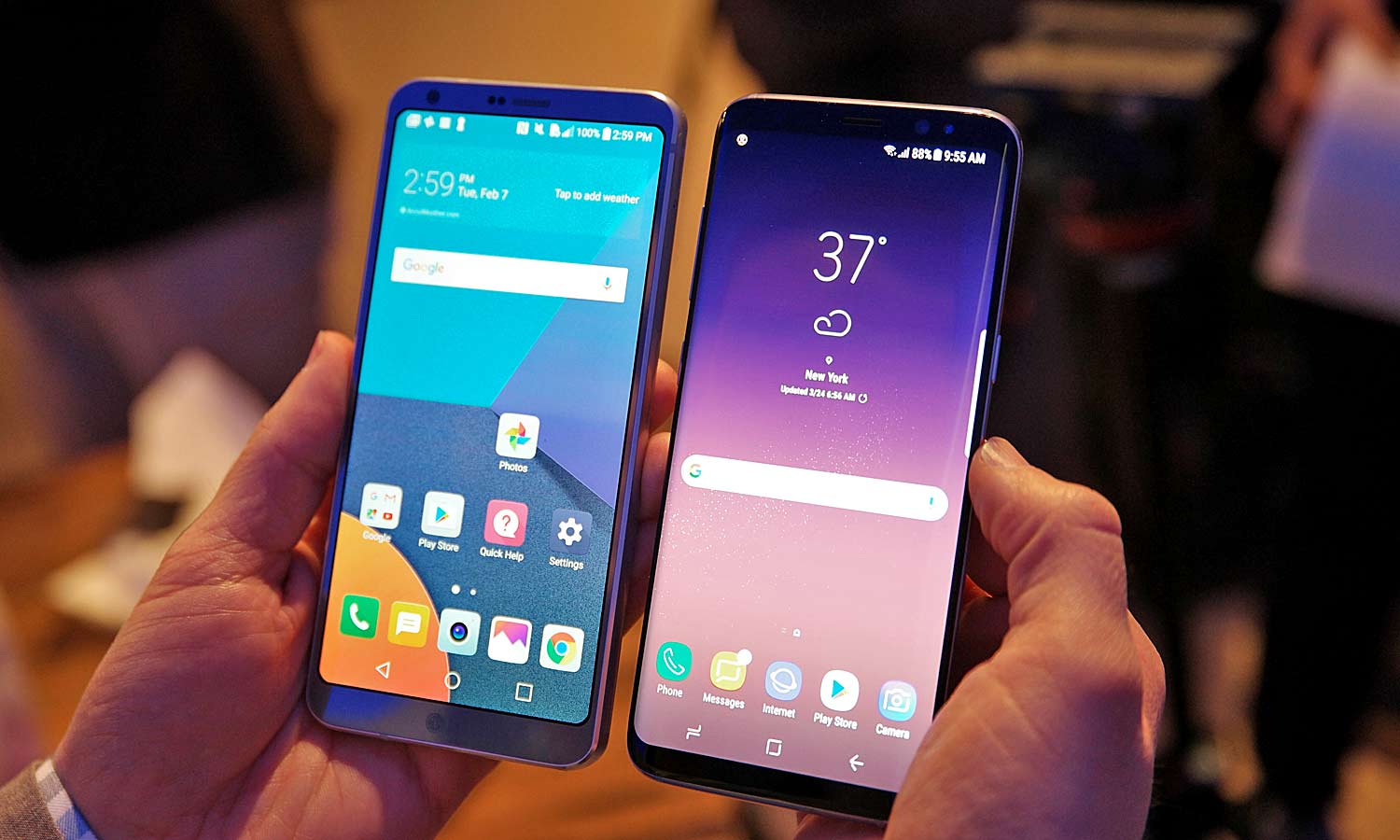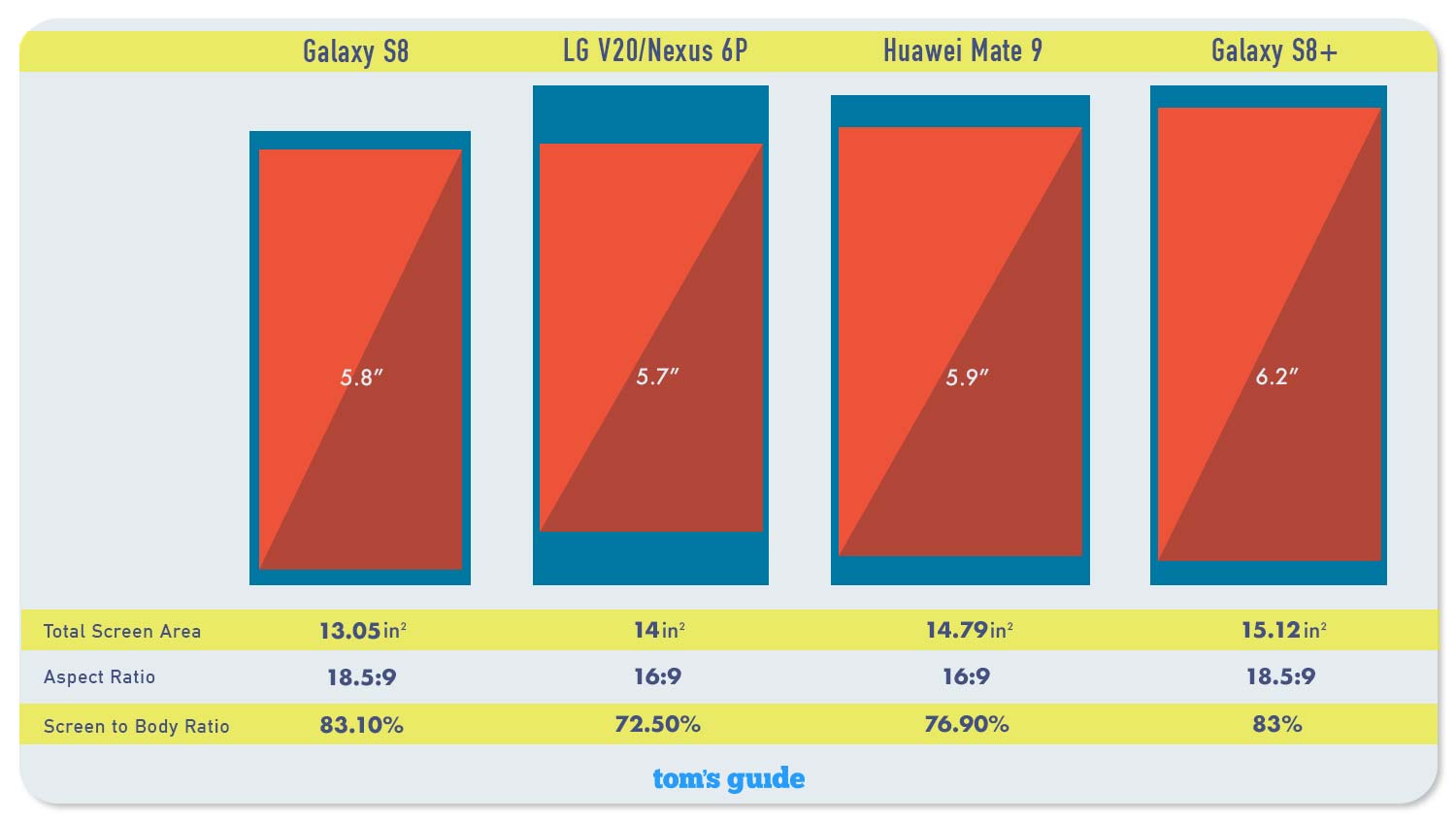How To Turn Off Data For Certain Apps Galaxy S8
How Big Is the Galaxy S8's Screen, Really?
The Samsung Galaxy S8 and LG G6 are pioneering a new trend for smartphones: big screens that sport extra-wide aspect ratios. This change promises improved one-handed usability, more vertical screen real estate and immersive video watching.

However, these new screens also cause a problem when you try to compare them to phones that have more traditional displays with 16:9 aspect ratios: It's difficult to figure out just how much extra screen space you're getting. To answer that question for the Galaxy S8 and S8+, we crunched some numbers to help better illustrate the differences.
Who Offers the Most Screen Space?
| Phone | Screen Size (measured diagonally) | Aspect Ratio | Total Screen Area (square inches) | Body Size (inches) | Screen to Body Ratio |
| Galaxy S8 | 5.8 inches | 18.5:9 | 13.05 | 5.86 x 2.68 x 0.31 | 83.1% |
| Galaxy S8+ | 6.2 inches | 18.5:9 | 15.12 | 6.28 x 2.89 x 0.32 | 83% |
| iPhone 7 | 4.7 inches | 16:9 | 9.43 | 5.44 x 2.64 x 0.28 | 65.6% |
| iPhone 7 Plus | 5.5 inches | 16:9 | 12.96 | 6.23 x 3.07 x 0.29 | 67.7% |
| LG G6 | 5.7 inches | 18:9 | 12.75 | 5.86 x 2.83 x 0.31 | 76.8% |
| LG V20 | 5.7 inches | 16:9 | 14 | 6.29 x 3.07 x 0.30 | 72.5% |
| Google Pixel | 5 inches | 16:9 | 11 | 5.66 x 2.74 x 0.33 | 70% |
| Google Pixel XL | 5.5 inches | 16:9 | 12.96 | 6.09 x 2.98 x 0.33 | 71.4% |
| Huawei Mate 9 | 5.9 inches | 16:9 | 14.79 | 6.18 x 3.11 x 0.31 | 76.9% |
Looking at diagonal screen size (typically the dimension used when measuring displays), you might think that the Galaxy S8's 5.8-inch display boasts more screen real estate than a 5.7-inch handset like the LG V20 or Nexus 6P. But that's not the case at all. While the S8's 18.5:9 aspect ratio is taller from top to bottom, it's also narrower. So, instead of looking at the diagonal measurement, we needed to figure out each screen's total area. Thankfully, since we know each screen's diagonal length and its aspect ratio, total screen area is pretty easy to figure out.
Next, let's compare the standard Galaxy S8 and a selection of its comparably sized competition. Technically, the S8 and G6 have screens with rounded corners, which affects overall screen real estate, but since those areas are so small, we've decided not to include them in our calculations.

From this chart, we can see that the S8 has a bigger screen than even phones that border on being called phablets, like the 5.5-inch Pixel XL and iPhone 7 Plus. What's more, with a body measuring 5.86 inches tall and 2.68 wide, the S8's body is significantly smaller than those on the Pixel XL (6.09 x 2.98 inches) and iPhone 7 Plus (6.23 x 3.07 inches).
However, the most shocking difference comes when you compare the S8 to the regular iPhone 7. At 2.64 inches wide, the iPhone 7 has essentially the same width as the S8. And while the iPhone 7 is a bit shorter at 5.44 inches, that's not nearly enough to make you feel good about it having a screen that's almost 30 percent smaller than Samsung's Galaxy S8.
Compared to the LG G6, the S8's screen is insignificantly larger. However, because LG's phone doesn't feature curved edges like Samsung's new devices, you could argue that the G6 sports more usable screen area. And you don't get any of the image distortion or warping that you see on the S8, either.
Now, we can move on to the larger end of the phone spectrum to see how the S8+ stacks up against its big-screen brethren.

With a total screen area of 15.12 square inches, the S8+ really is the new king of big-screen phones. It tops even the 5.9-inch Huawei Mate 9 and its 14.79-square-inch screen, which was previously my go-to recommendation for people who really wanted an immersive media experience. With a body measuring 6.28 x 2.89 inches, the S8+ is also way easier to hold and use one-handed than the 6.18 x 3.11-inch Huawei Mate 9.
At the end of the day, it's pretty clear this extra-wide-screen trend for phones is more than a gimmick. Both the Samsung Galaxy S8 and the LG G6 pack bigger screens in less space than ever before. Even though not every app fully supports these new 18:9 ratios, the worst thing that happens is that you're left with a couple small black bars and screens that still offer up as much space as their 16:9 counterparts. And with Google pushing app developers to take advantage of phones with larger aspect ratios, the extra-wide-screen experience is only going to get better.
Illustration Credit: Tom's Guide
- Best Big Phones
- Galaxy S8 vs. Galaxy S8+: Which Phone Should You Get?
- The Best New Features of the Galaxy S8
Sam is a senior reporter at Gizmodo, formerly Tom's Guide and Laptop Mag. Was an archery instructor and a penguin trainer before that.
How To Turn Off Data For Certain Apps Galaxy S8
Source: https://www.tomsguide.com/uk/us/galaxy-s8-screen-size-compared,news-24927.html
Posted by: hatcherdeconsenry.blogspot.com

0 Response to "How To Turn Off Data For Certain Apps Galaxy S8"
Post a Comment